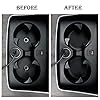SINGARO Car Cup Coaster, 4PCS Universal Non-Slip Cup Holders Embedded in Ornaments Coaster, Car Interior Accessories, Black
33% OffStellar Blade - PlayStation 5
$69.00 (as of April 29, 2024 15:54 GMT +00:00 - More infoProduct prices and availability are accurate as of the date/time indicated and are subject to change. Any price and availability information displayed on [relevant Amazon Site(s), as applicable] at the time of purchase will apply to the purchase of this product.)As a Python programmer, you’ll often need to remove punctuation marks from strings to prepare text data for processing. Mastering punctuation removal enables better text analysis, natural language processing, machine learning, and more.
This comprehensive guide covers key skills for efficiently stripping punctuation from strings in Python.
Why Punctuation Removal is Vital for Python Programmers
Removing punctuation marks from strings provides important benefits for Python programmers:
- Cleanses text data for more accurate analytics and models
- Removes noise to focus algorithms on textual content
- Normalizes data by eliminating inconsistent punctuation
- Improves processing of user-generated text and web content
- Simplifies strings for tasks like sorting, grouping, and clustering
- Prepares data for machine learning model training
Overall, punctuation removal is an essential technique for any application involving text manipulation.
Key Methods for Removing Punctuation in Python
Python offers several straightforward ways to strip punctuation:
Use str.replace() to Replace Individual Marks
Replace specific punctuation with empty strings:
text = text.replace(",", "")
text = text.replace("!", "")str.translate() for Full Punctuation Removal
Pass a translation table mapping punctuation to None:
import string
table = str.maketrans('', '', string.punctuation)
clean_text = text.translate(table)Regular Expressions with re.sub()
Use regex to find and replace all punctuation:
import re
import string
pattern = r'[{}]'.format(re.escape(string.punctuation))
clean_text = re.sub(pattern, '', text)For Loops to Iterate Through Characters
Build a new string excluding punctuation:
clean_text = ""
for char in text:
if char not in string.punctuation:
clean_text += charKey Factors When Removing Punctuation in Python
Consider these key factors when stripping punctuation:
- Test approaches on datasets to measure impact.
- Balance performance vs. simplicity for your use case.
- Remember context – sometimes punctuation provides value.
- Handle languages beyond English when appropriate.
- Customize solutions to only remove unwanted punctuation.
- Utilize raw strings with regex to avoid escaping issues.
- Comment code clearly explaining your approach.
Conclusion – Essential Text Cleansing Skills for Python
- Removing punctuation is vital preparation for textual data.
- Python offers flexible and efficient options to strip punctuation.
- Solutions range from simple replaces to regex expressions.
- Clean punctuation-free text leads to better analysis and models.
- Mastering punctuation removal will improve your Python text processing skills.
Let me know if this revised version helps demonstrate the value and techniques for removing punctuation in Python more clearly. Please provide any feedback to help further optimize the content.
FAQs
-
Will punctuation removal affect contractions like “don’t” or possessive forms like “John’s”?
Yes, indiscriminate punctuation removal might affect contractions and possessive forms. It’s essential to consider the context and avoid over-removing punctuation marks.
-
Can I remove punctuation from multiple strings simultaneously?
Yes, you can apply punctuation removal techniques to a list of strings using loops or list comprehensions.
-
Are there cases where I should not remove punctuation?
In some text analysis tasks, preserving certain punctuation marks might be important. For instance, sentiment analysis might require preserving exclamation marks.
-
How do I deal with languages that use punctuation differently?
Consider using language-specific tokenization tools or libraries that provide built-in support for handling punctuation in different languages.
-
Should I remove all punctuation for every text analysis task?
The decision to remove punctuation depends on the specific task and the nature of the text data. Some tasks might require more fine-tuned handling of punctuation.
-
Can I use punctuation removal for numerical data or codes?
Punctuation removal is generally not recommended for numerical data or codes, as it may alter their meaning. It’s best suited for textual data.
























